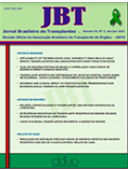N-acetylcysteine use in a Pediatric Patient with Severe Early Allograft Dysfuntion: Case Report
DOI:
https://doi.org/10.53855/bjt.v24i2.20Keywords:
Acetylcysteine, Primary Graft Dysfunction, Graft Survival, Liver Transplant, PediatricsAbstract
Early allograft dysfunction consists of a multifactorial syndrome characterized by clinical and laboratory abnormalities associated to high morbidity in the early postoperative period. As to liver ischemia and reperfusion injury, in its most severe form it can lead to sudden systemic changes. Despite being a serious condition, it may be transient, allowing recovery of the liver graft. Its occurrence in pediatric population is rare. N-acetylcysteine, commonly used to treat hepatotoxicity secondary to paracetamol overdose, has emerged as an effective alternative in the clinical improvement of transplant results in patients with poor graft function. Patient was two-year-old male, who underwent liver transplantation due to biliary atresia with no intraoperative complications. The patient evolved with severe early graft dysfunction on the second postoperative day, with no good response to supportive procedures, and indication for retransplantation has been considered. Administration of n-acetylcysteine started with a 100mg dosage three times a day, progressing with significant clinical improvement, especially in the liver function of the patient. Clinical and laboratory monitoring in the post-transplant period is essential, due to the risks and serious repercussions of early liver graft dysfunction. N-acetylcysteine is a drug reported to act increasing the supply of tissue oxygen and in remodeling hepatocytes from the recovery of the glutathione levels. Effects in patients with post-transplant liver dysfunction have been promising in few scientific reports as to its use, as the case in question.









